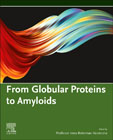
From Globular Proteins to Amyloids proposes a model and mechanism for explaining protein misfolding. Concepts presented are based on a model originally intended to show how proteins attain their native conformations. This model is quantitative in nature and founded upon arguments derived from information theory. It facilitates prediction and simulation of the amyloid fibrillation process, also identifying the progressive changes that occur in native proteins that lead to the emergence of amyloid aggregations. Introduces basic rules for protein folding, along with the conditions that result in misfoldingPresents research that lies in treating the aqueous environment as a continuum rather than a set of individual water molecules (i.e. the classic representation)Provides practical applications for helping the prevention of amyloidosis and improving drug design INDICE: 1. Description of the fuzzy oil drop model 2. Folding with the active participation of water 3. Information coded in protein structure 4. Gobular or ribbon-like micelle 5. Proteins structured as spherical micelles 6. Local discordance 6. A. The active site in a single-chain enzyme identified as local deficiency of hydrophobicity 6. B. Protein-protein interaction encoded as an exposure of hydrophobic residues on the surface 6. C. Ligand binding cavity coded in form of local deficiency of hydrophobicity 7. Solenoid - amyloid under control 8. Composite structures 9. Permanent chaperons 9. A. Non-amyloid structure of the aß(1-42) polypeptide requiring a permanent chaperone 9. B. Structural properties of aß(1-42) chain fragments in complex with proteins acting as permanent chaperones 10. Amyloids 10. A. Amyloid as a ribbon-like micelle 10. B. Alternative conformations of the aß(1-40) amyloid protein 10. C. Specificity of amino acid sequence and its role in secondary and super secondary structure generation 11. Anti-amyloid drug design 12. Predicted structure of the transthyretin amyloid
- ISBN: 978-0-08-102981-7
- Editorial: Elsevier
- Encuadernacion: Rústica
- Páginas: 278
- Fecha Publicación: 02/10/2019
- Nº Volúmenes: 1
- Idioma: Inglés
